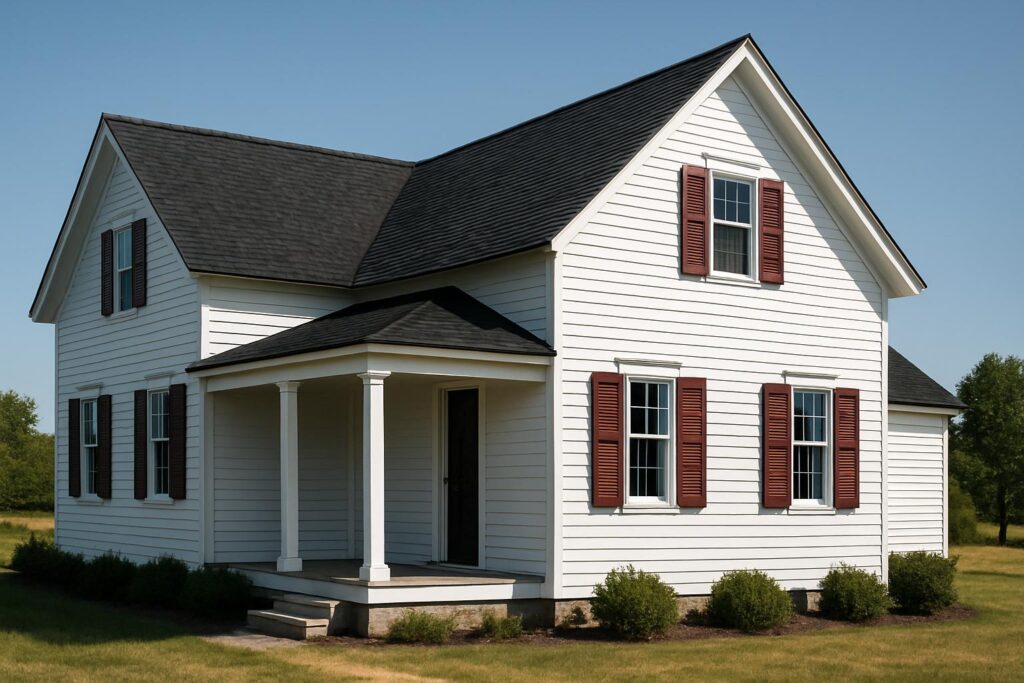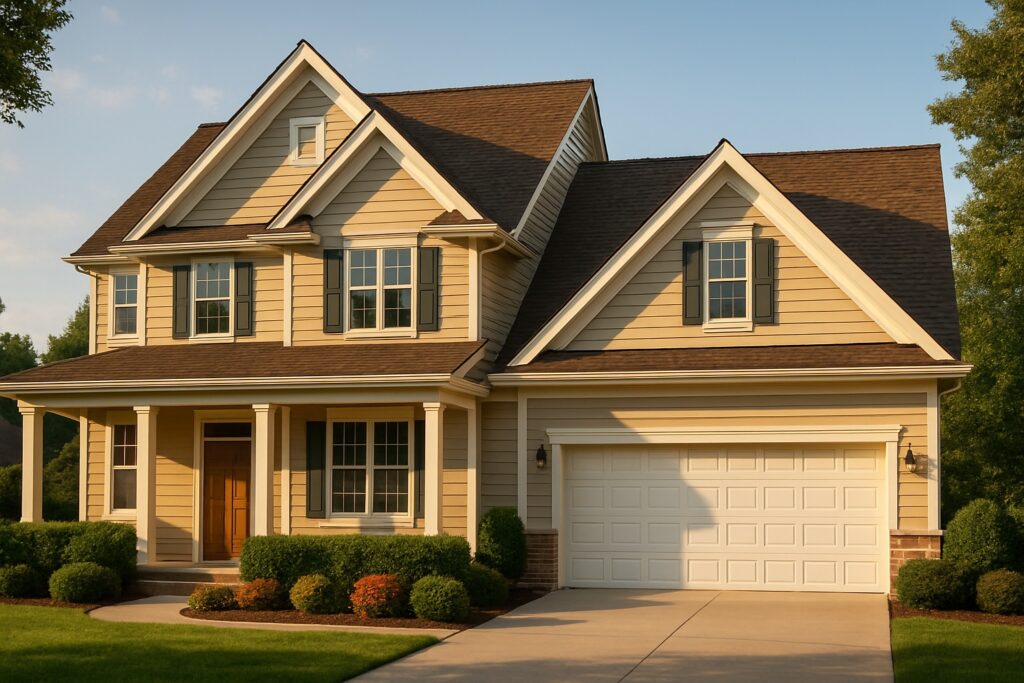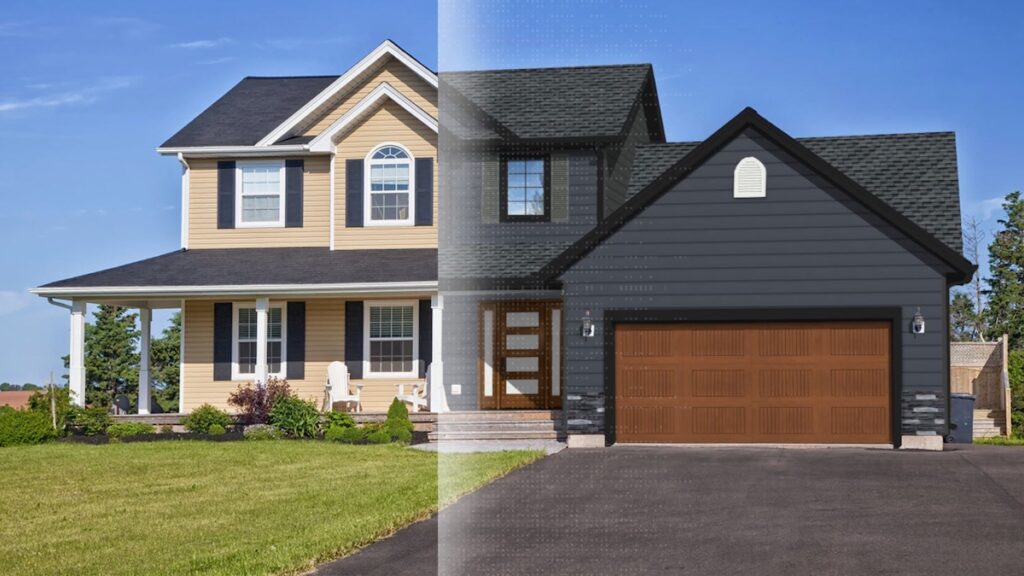Listen Now: Cheapest Siding Options Explained
TLDR
Looking to refresh your home’s exterior without overspending? These cheap siding options balance affordability, durability, and style:
- Vinyl Siding: The most budget-friendly, easy to install, and low-maintenance option.
- Engineered Wood Siding: A cost-effective way to get a natural wood look with better pest resistance.
- Fiber Cement Siding: More durable and fire-resistant than vinyl, with a longer lifespan but higher upfront costs.
- Aluminum Siding: Affordable and weather-resistant, but prone to dents.
- Steel Siding: Higher initial investment, but it lasts longer and requires minimal upkeep.
- Board & Batten or Wood Variations: Classic, rustic look, but requires regular maintenance.
Key Factors to Consider
- Material vs. Labor Costs: Some siding materials are cheaper to buy but more expensive to install.
- Regional Climate: Choose siding that holds up well in your local weather conditions.
- Maintenance Needs: Budget-friendly siding options like vinyl and aluminum require less upkeep.
- Energy Efficiency: Well-insulated siding can reduce your heating and cooling costs over time.
Your Action Plan
- Evaluate your budget to find the best siding option for your home.
- Get quotes from local contractors to compare installation costs.
- Consider long-term maintenance when choosing materials to avoid unexpected expenses.
Not sure which siding option is right for your home? Try our free Siding Visualizer Tool to see how different materials and colors will look on your house before you commit. Start designing today!
Introduction
When you’re on a budget but want to upgrade your home’s curb appeal, siding options can feel like a big expense. Yet “cheap” doesn’t have to mean “low quality.” With the right knowledge, you can find siding options that balance affordability with durability and style. Below, you’ll discover cost-effective materials, compare pros and cons, and learn tips to make the most of your investment—so you can transform your home’s exterior without breaking the bank.
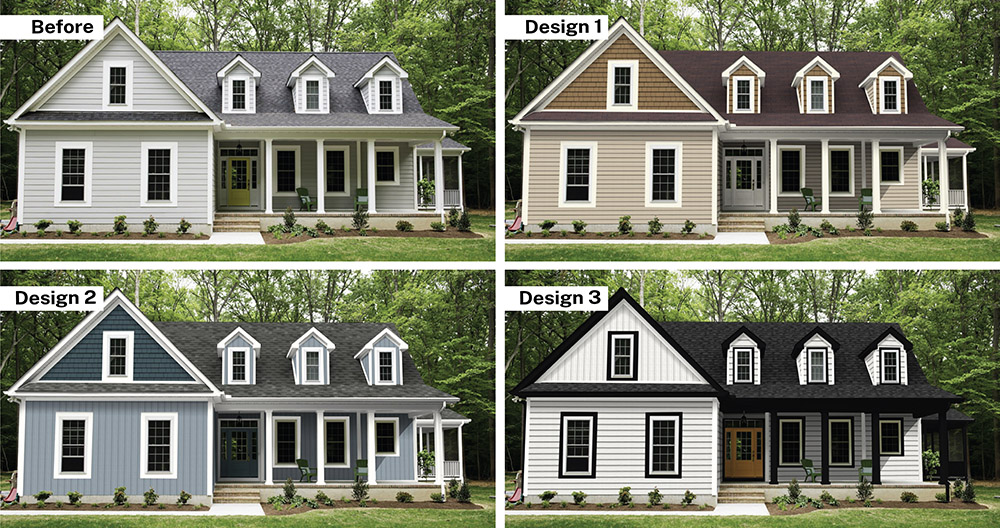
Why Cheap Siding Matters
Balance Cost and Value
You want your home to look great—but you shouldn’t have to overspend on siding material to get there. Whether you’re renovating a starter home or revamping an older property, cheap siding options let you:
Protect your exterior from weather and pests
Boost curb appeal without a major financial burden
Save on maintenance with easy-to-clean, long-lasting side materials
Think Long-Term
While “cheap” focuses on the upfront price, consider how maintenance, lifespan, and repair costs add up over time. Vinyl siding, for instance, might cost a bit more than a low-grade wood side, but can save you money on repainting and pest treatments. The key is finding the best balance between immediate budget and long-term value.
Factors That Affect Siding Cost
Material vs. Labor
It’s easy to focus on the per-square-foot price of the side material itself, but installation can be just as significant. Vinyl side panels, for example, are typically simpler to install than fiber cement side products, meaning labor costs could be lower if you hire a pro—or easier if you tackle a small area yourself.
Regional & Climate Considerations
If you live in an area prone to wildfires, choosing fire-resistant siding like fiber cement can be a smart, cheap side decision. In humid climates, a resistant side material can help you avoid rot or mold. Always factor in your local weather before finalizing a siding choice.
Maintenance & Upkeep
Some types of side options—such as board and batten wood siding—require frequent sealing or paint touch-ups. Meanwhile, vinyl side products or fiber cement side options tend to be more low maintenance. Paying a bit more for a durable material often means fewer headaches (and costs) down the road.
Energy Efficiency
Well-insulated siding can reduce energy bills, so your upfront costs might be offset by lower heating and cooling expenses. If insulation matters in your area, look for siding products with a higher R-value (a measure of insulation) that help preserve your home’s exterior side.
Top 7 Cheap Siding Options
Below, you’ll find some of the most budget-friendly siding choices. Each one has unique benefits and drawbacks—review them to decide which best suits your home’s needs.
Vinyl Siding
Vinyl is one of the most popular cheap siding options for a reason: it’s affordable, low maintenance, and widely available.
Pros
Cost-Effective: Vinyl often offers the lowest per-square-foot price.
Easy to Clean: A quick rinse with a garden hose removes most dirt and grime.
Weather-Resistant: It won’t rot or warp in moisture-heavy environments.
Cons
Susceptible to Dents and Cracks: Severe hail or impact can damage the panels.
Less Fire-Resistant: Not recommended for areas with high wildfire risk.
Engineered Wood Siding & Composite Wood Siding
Wood siding or engineered wood siding combines real wood fibers with bonding materials to create a product that looks like real wood but usually costs less.
Pros
Natural Look: Get a rustic, wood-like appearance without paying a premium.
Resistant to Pests and Rot (more so than raw wood).
Moderate Maintenance: Usually needs repainting every 5–10 years, not every 2–3.
Cons
Less Durable than fiber cement or vinyl.
May still require paint or sealant to maximize lifespan.
Fiber Cement Siding
Fiber cement siding is a type of siding that blends cement, sand, and cellulose fibers. Although its initial cost can be higher than vinyl, it remains a solid budget friendly pick when you consider its durability.
Pros
Highly Durable & Fire-Resistant
Low Maintenance: Rarely warps, rots, or succumbs to pests.
Excellent Curb Appeal: Many brands offer realistic wood grain textures.
Cons
Heavier Material: Installation is more complex, often requiring professionals.
Costs a bit more upfront compared to vinyl.
Pro Tip: Engineered wood can still be susceptible to moisture damage if the paint or sealant wears off. Keep an eye on exposed edges to avoid damage.
Aluminum Siding
Aluminum siding has been around for decades and is another tried-and-true low cost siding material option, especially if you find a good local deal.
Pros
Fire-Resistant and does not rust.
Requires minimal upkeep other than the occasional washing.
Cons
Easily Dented by hail, rocks, or even a rogue baseball.
Older finishes can become chalky, possibly needing repainting to maintain appearance.
Steel & Other Metal Siding
While steel siding sometimes comes with a higher price tag, it’s incredibly tough and may pay for itself if you want something that lasts.
Pros
Excellent Durability against extreme weather, pests, and fire.
Low long-term costs since it rarely needs major repairs.
Cons
Heavier and more challenging to install.
Typically has a bigger initial outlay than vinyl or aluminum.
Board and Batten & Other Wood Variations
If you’re after a rustic or farmhouse exterior, board and batten or cedar siding can be surprisingly affordable under the right conditions.
Pros
Classic, Natural Look: Perfect for country or craftsman-style homes.
Can be sourced locally, sometimes reducing low cost shipping fees.
Cons
Maintenance-Heavy: You’ll likely need to paint or seal every few years.
Wood is more prone to damage from insects or rot if not well maintained.
Stucco, Brick, and Alternatives
Stucco and brick veneers aren’t always “cheap,” but in some regions they can be cost-competitive and energy-efficient.
Stucco
Pros: Fire-resistant, good insulation, appealing texture.
Cons: Higher labor costs; cracks can appear if installed incorrectly.
Brick Veneer
Pros: Classic, upscale look with great durability.
Cons: Material costs can be higher, not always “budget friendly.”
HOME VISUALIZER TOOL
Still Imagining? Start Designing.
Visualize your home — for free. Instantly explore siding styles, colors, and renovations with just one photo. No forms. No pressure. Just results.
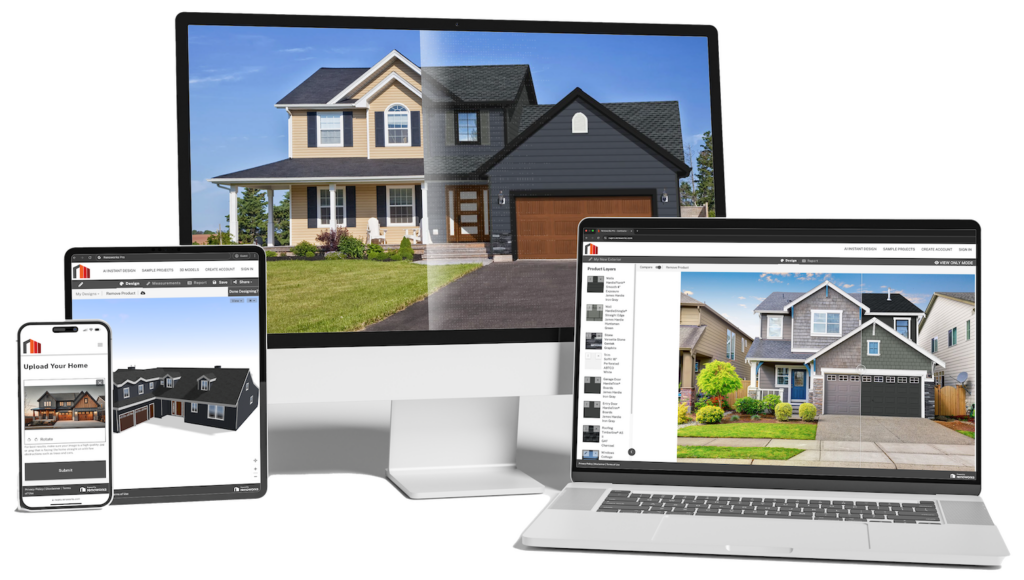
Additional Considerations
Climate & Weather
If you live in a cold northern climate, you’ll benefit from a siding option with insulative properties. In areas prone to hurricanes, look for wind-rated panels.
DIY vs. Professional Installation
Vinyl can be more user-friendly if you’re relatively handy. Fiber cement, on the other hand, often requires specialized tools and safety gear. If in doubt, consult a pro—botched installations can lead to bigger, pricier problems down the line.
Local Building Codes
Always check with your municipality for specific code requirements. Some areas may require flame spread ratings or specific fire resistant materials, which might influence your final pick.
Balancing Short-Term and Long-Term Costs
Short-Term: Materials like vinyl or aluminum often have the lowest upfront price.
Long-Term: Fiber cement or steel might cost more now but require fewer repairs and less upkeep, potentially saving you money over decades.
Cost and ROI at a Glance
| Material | Cost/Sq. Ft. | Maintenance | Expected Lifespan |
|---|---|---|---|
| Vinyl Siding | $2 – $7 | Low | 20–30 years |
| Fiber Cement | $5 – $10 | Low to Moderate | 30–50 years |
| Engineered Wood | $3 – $8 | Moderate | 20–30 years |
| Aluminum | $3 – $6 | Low | 20–40 years |
| Steel | $5 – $12 | Very Low | 40+ years |
| Board & Batten Wood | $2 – $9 | High | 15–25 years |
Quick Installation & Upkeep Tips
Prep Your Walls: Repair any structural issues before adding siding. This prevents hidden rot or moisture problems.
Seal and Paint (If Needed): Materials like wood or engineered wood often need a protective coat.
Regular Inspection: Once or twice a year, walk around your home and check for dents, cracks, or loose panels. Catching small problems early helps you avoid costly damage.
Proper Cleaning: A gentle pressure wash or garden hose is usually enough to keep vinyl or metal siding looking fresh.
Conclusion & Next Steps
Choosing cheap siding options doesn’t mean sacrificing quality. By comparing costs, weighing pros and cons, and thinking about your climate, you can find a siding material that keeps more money in your pocket and still looks fantastic on your home. Whether you opt for vinyl, fiber cement, or an engineered wood product, remember to plan for maintenance and installation to make your budget stretch further.
Your Action Plan:
Evaluate Your Budget: Determine how much you can comfortably invest upfront.
Research Local Pros: Request quotes for two or three materials. Ask about installation fees, warranties, and references.
Check Maintenance Requirements: Consider how often you’re willing (or able) to repaint, clean, or repair siding.
Stay Code-Compliant: If you live in an area with specific building or fire codes, factor that into your decision.
By staying informed and comparing your options, you can confidently pick a cheap siding solution that’ll protect your home and look great for years to come. If you still have questions, don’t hesitate to consult a local contractor or building supplier for personalized advice.
Try Our Siding Visualizer Tool
Design your dream exterior in minutes with Renoworks’ interactive tool—perfect for homeowners, remodelers, and pros alike.
Frequently Asked Questions
Q: What is the absolute cheapest siding material?
A: In many areas, vinyl will be your most affordable option. However, sometimes local deals on aluminum or wood offcuts can compete on price.
Q: Is cheap siding low quality?
A: Not necessarily. The term “cheap” often refers to initial cost. Vinyl or fiber cement can be both budget friendly and durable when properly installed and maintained.
Q: Can I paint vinyl siding if I want to change the color?
A: Yes. You’ll need a paint specifically formulated for vinyl, and proper preparation (cleaning, priming) is crucial. Painted vinyl may need refreshes every 5–10 years.
Q: Are there eco-friendly cheap siding options?
A: Engineered wood uses fewer raw timber resources than solid wood and can be a greener choice. Fiber cement also rates well for eco-friendliness due to its longevity and recycled content.




